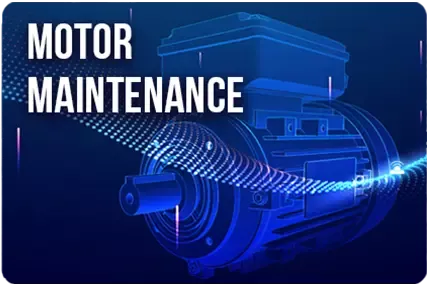Table of contents
- Overview of a Heating, Ventilation, and Air Conditioning (HVAC) system
- Overview of an Air Treatment Center (ATC)
- The challenges of maintaining Heating, Ventilation, and Air Conditioning (HVAC) systems in commercial buildings
- Which HVAC equipment to prioritize monitoring through predictive maintenance?
- Fans (blowing and extraction)
- Electric motors of fans
- Hot/Cold Water Pumps (Hydraulic Circuits)
- Compressors (integrated refrigeration circuit)
- Rotary heat exchangers (if present)
- The benefits of predictive maintenance for HVAC systems
- Presentation of our predictive maintenance solution for HVAC systems
- Steps to implement our predictive maintenance solution on an HVAC system
- Conclusion on the implementation of a predictive maintenance solution on an HVAC or CTA system

Overview of a Heating, Ventilation, and Air Conditioning (HVAC) system
A tertiary HVAC system combines ventilation, heating, and air conditioning to ensure thermal comfort and indoor air quality.
Its key components are organized as follows: ventilation (introduction of fresh air and extraction of stale air) ensures a constant renewal of indoor air, heating (for example, via boilers supplying radiators or underfloor heating) maintains a pleasant temperature in winter, and air conditioning (centralized systems or ducted VRF/DRV units) cools the air in summer.
These systems work in concert: fresh outdoor air is introduced and distributed throughout the building, while stale air is expelled outside, often through a dual-flow air handling unit.
Most modern tertiary buildings also integrate a separate smoke extraction system (natural or mechanical safety ventilation) distinct from the comfort HVAC, designed to evacuate smoke in case of fire.
The entire HVAC system is controlled by a technical regulation of the building to adjust indoor conditions according to needs and achieve energy savings.
Its key components are organized as follows: ventilation (introduction of fresh air and extraction of stale air) ensures a constant renewal of indoor air, heating (for example, via boilers supplying radiators or underfloor heating) maintains a pleasant temperature in winter, and air conditioning (centralized systems or ducted VRF/DRV units) cools the air in summer.
These systems work in concert: fresh outdoor air is introduced and distributed throughout the building, while stale air is expelled outside, often through a dual-flow air handling unit.
Most modern tertiary buildings also integrate a separate smoke extraction system (natural or mechanical safety ventilation) distinct from the comfort HVAC, designed to evacuate smoke in case of fire.
The entire HVAC system is controlled by a technical regulation of the building to adjust indoor conditions according to needs and achieve energy savings.
Overview of an Air Treatment Center (ATC)
The air handling unit (AHU) is the "lung" of the HVAC system: it ensures the centralized treatment of the ventilated air in the building.
A double-flow AHU captures outdoor air (fresh air), filters it to eliminate dust and pollutants, and then passes it over heating or cooling batteries to adjust its temperature according to needs (heating the air in winter, cooling it in summer). The treated air is then supplied to the rooms via a network of ducts and diffusers.
At the same time, the AHU extracts stale air from the rooms (loaded with CO₂, humidity, odors) to discharge it outside, ensuring a constant renewal of the indoor air. In modern AHUs, a heat exchanger allows for the recovery of energy from the extracted air (for example, heat in winter) and transfers it to the incoming air, reducing the energy consumption of the system.
In summary, the AHU continuously provides clean air at a comfortable temperature in the building while evacuating polluted air, thus contributing to the comfort of the occupants and the energy efficiency of the tertiary building.
A double-flow AHU captures outdoor air (fresh air), filters it to eliminate dust and pollutants, and then passes it over heating or cooling batteries to adjust its temperature according to needs (heating the air in winter, cooling it in summer). The treated air is then supplied to the rooms via a network of ducts and diffusers.
At the same time, the AHU extracts stale air from the rooms (loaded with CO₂, humidity, odors) to discharge it outside, ensuring a constant renewal of the indoor air. In modern AHUs, a heat exchanger allows for the recovery of energy from the extracted air (for example, heat in winter) and transfers it to the incoming air, reducing the energy consumption of the system.
In summary, the AHU continuously provides clean air at a comfortable temperature in the building while evacuating polluted air, thus contributing to the comfort of the occupants and the energy efficiency of the tertiary building.
The challenges of maintaining Heating, Ventilation, and Air Conditioning (HVAC) systems in commercial buildings
Heating, Ventilation, and Air Conditioning (HVAC) systems, particularly Air Handling Units (AHU), are essential for comfort and air quality in commercial buildings. However, these complex systems, integrating numerous rotating machines such as motors, fans, or compressors, can experience unexpected failures leading to high intervention costs and significant disruptions for users.
To address these challenges, Integral System offers an innovative predictive maintenance solution based on vibration analysis. Thanks to non-intrusive smart sensors positioned directly on HVAC and AHU equipment, our system collects and analyzes machine vibrations in real-time, thus detecting any signs of wear or malfunction at an early stage.
Coupled with an advanced software platform utilizing artificial intelligence, our tool provides an accurate diagnosis of the current health status of the equipment and predicts their evolution over several days. This way, you can effectively anticipate failures, optimize maintenance costs, and ensure maximum availability of your HVAC systems.
To address these challenges, Integral System offers an innovative predictive maintenance solution based on vibration analysis. Thanks to non-intrusive smart sensors positioned directly on HVAC and AHU equipment, our system collects and analyzes machine vibrations in real-time, thus detecting any signs of wear or malfunction at an early stage.
Coupled with an advanced software platform utilizing artificial intelligence, our tool provides an accurate diagnosis of the current health status of the equipment and predicts their evolution over several days. This way, you can effectively anticipate failures, optimize maintenance costs, and ensure maximum availability of your HVAC systems.
Which HVAC equipment to prioritize monitoring through predictive maintenance?
Our predictive maintenance solution, based on vibration analysis and artificial intelligence, enables proactive monitoring of the main mechanical equipment of your Air Treatment Center (ATC). Here are the main elements you can monitor :

Fans (blowing and extraction)
Monitoring : Rotations, blade balancing, shaft alignment, and abnormal vibrations.
Benefits : Anticipate critical failures and avoid sudden stops that disrupt your activity.
Benefits : Anticipate critical failures and avoid sudden stops that disrupt your activity.

Electric motors of fans
Monitoring : Bearing wear, mechanical misalignment, electrical and mechanical imbalance, overheating.
Benefits : Extend the lifespan of motors, reduce energy consumption, and avoid costly emergency interventions.
Benefits : Extend the lifespan of motors, reduce energy consumption, and avoid costly emergency interventions.

Hot/Cold Water Pumps (Hydraulic Circuits)
Monitoring : Bearings, condition of mechanical components, early detection of cavitation.
Benefits : Optimize the hydraulic operation of the HVAC system, reduce the risk of failures, and improve operational efficiency.

Compressors (integrated refrigeration circuit)
Monitoring : Vibration level, internal mechanical state, evolution of operational performance.
Benefits : Ensure energy performance and anticipate costly repairs of refrigeration systems.
Benefits : Ensure energy performance and anticipate costly repairs of refrigeration systems.

Rotary heat exchangers (if present)
Monitoring : Status of bearings, operation of the drive motor, rotor balancing.
Benefits : Ensure optimal efficiency in energy recovery and avoid costly malfunctions.
Benefits : Ensure optimal efficiency in energy recovery and avoid costly malfunctions.
The benefits of predictive maintenance for HVAC systems
Implementing a predictive maintenance strategy on your HVAC systems offers concrete and immediate benefits.
First, by detecting anomalies early, you significantly reduce unexpected breakdowns, thereby increasing the reliability and availability of your equipment.
Moreover, through continuous monitoring and in-depth analysis of vibrational data, you sustainably optimize the energy performance of your installation, leading to a notable reduction in operating costs related to energy and maintenance interventions.
Finally, by anticipating wear and malfunctions, you effectively extend the lifespan of your equipment, thus protecting your investment in the long term.
First, by detecting anomalies early, you significantly reduce unexpected breakdowns, thereby increasing the reliability and availability of your equipment.
Moreover, through continuous monitoring and in-depth analysis of vibrational data, you sustainably optimize the energy performance of your installation, leading to a notable reduction in operating costs related to energy and maintenance interventions.
Finally, by anticipating wear and malfunctions, you effectively extend the lifespan of your equipment, thus protecting your investment in the long term.
Learn more about predictive maintenance
Discover our detailed page on predictive maintenance
Learn morePresentation of our predictive maintenance solution for HVAC systems
Our predictive maintenance solution dedicated to HVAC systems relies on non-intrusive smart sensors, such as the Wise-2410 model, which can be quickly and easily installed on your existing equipment, including air handling units (AHU).
These sensors, fixed by a magnetic, adhesive, or screwed mount, precisely measure the vibrations and temperature of the equipment to detect any mechanical anomalies at their first signs.
The continuously collected data is transmitted wirelessly and securely through a LoRaWAN gateway (Wise-6610), ensuring reliable, cost-effective, and autonomous on-site coverage.
This information is then processed by our intelligent software Wise-IoT/PHM, equipped with a powerful artificial intelligence algorithm. It evaluates in real-time the current health status of your equipment in the form of an easy-to-interpret score, and accurately predicts their evolution over the coming days.
You can thus anticipate maintenance needs, intervene at the right time, and sustainably optimize the performance of your HVAC installations.
These sensors, fixed by a magnetic, adhesive, or screwed mount, precisely measure the vibrations and temperature of the equipment to detect any mechanical anomalies at their first signs.
The continuously collected data is transmitted wirelessly and securely through a LoRaWAN gateway (Wise-6610), ensuring reliable, cost-effective, and autonomous on-site coverage.
This information is then processed by our intelligent software Wise-IoT/PHM, equipped with a powerful artificial intelligence algorithm. It evaluates in real-time the current health status of your equipment in the form of an easy-to-interpret score, and accurately predicts their evolution over the coming days.
You can thus anticipate maintenance needs, intervene at the right time, and sustainably optimize the performance of your HVAC installations.
Steps to implement our predictive maintenance solution on an HVAC system
The implementation of our predictive maintenance solution on an HVAC system follows a simple, quick, and structured process.
It all starts with an initial assessment of needs, during which you identify the critical rotating equipment to monitor – such as fan motors, pumps, or compressors – and define the predictive maintenance objectives based on your operational priorities.
Next comes the installation of sensors, where vibration sensors are optimally positioned on the targeted equipment to ensure reliable and representative data collection.
Finally, our approach is part of a logic of continuous monitoring and optimization: the collected data is regularly analyzed, alert thresholds are refined, and artificial intelligence models are adjusted over time to improve the accuracy of predictions.
An alerting system is also put in place, allowing you to be automatically notified as soon as abnormal behavior is detected on one of your equipment.
It all starts with an initial assessment of needs, during which you identify the critical rotating equipment to monitor – such as fan motors, pumps, or compressors – and define the predictive maintenance objectives based on your operational priorities.
Next comes the installation of sensors, where vibration sensors are optimally positioned on the targeted equipment to ensure reliable and representative data collection.
Finally, our approach is part of a logic of continuous monitoring and optimization: the collected data is regularly analyzed, alert thresholds are refined, and artificial intelligence models are adjusted over time to improve the accuracy of predictions.
An alerting system is also put in place, allowing you to be automatically notified as soon as abnormal behavior is detected on one of your equipment.

Conclusion on the implementation of a predictive maintenance solution on an HVAC or CTA system
Predictive maintenance applied to HVAC systems represents a true advancement for managers of tertiary buildings looking to combine performance, reliability, and cost control.
Thanks to fine monitoring of critical equipment, real-time analysis of vibrational data, and the power of artificial intelligence, you can anticipate failures, optimize your maintenance, and extend the lifespan of your installations.
Would you like to know more about how our solution can adapt to your infrastructure and specific constraints? Our team is at your disposal to assist you in evaluating your needs and to offer you a customized deployment, simple, and fast. Do not hesitate to contact us to discuss your project.
Thanks to fine monitoring of critical equipment, real-time analysis of vibrational data, and the power of artificial intelligence, you can anticipate failures, optimize your maintenance, and extend the lifespan of your installations.
Would you like to know more about how our solution can adapt to your infrastructure and specific constraints? Our team is at your disposal to assist you in evaluating your needs and to offer you a customized deployment, simple, and fast. Do not hesitate to contact us to discuss your project.
Discover our ready to resell solutions

Customized solutions
You have a very specific project, very precise needs, need expertise ? Let's talk !
Contact us

